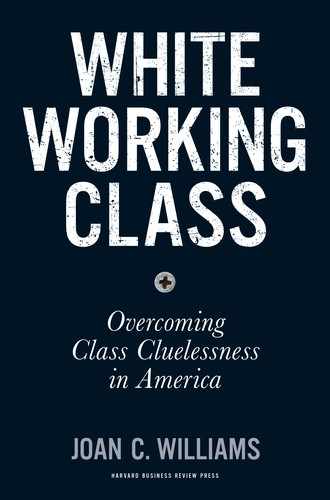| CHAPTER | 2 |
PRESUMABLY ON THE THEORY that no tree falls if no ear hears it, Americans curry a convenient deafness when it comes to class. A central way we make class disappear is to describe virtually everyone as “middle class.” A recent Bloomberg story quoted an amusement park worker earning $22,000 a year and a lawyer with an annual income of $200,000, both calling themselves middle class.9
I still remember my shock when a close friend, a professor married to a partner in a major D.C. law firm, referred to herself as middle class. At the time, she undoubtedly belonged to the top 1%. And that lawyer who earns $200,000 a year? His income places him in the top 6% of American earners.10 The working class is wise to such people: to working-class minds, lawyers (and doctors and bankers) aren’t middle class. They are simply rich.
Objectively, the working class has a much better claim to middle-class standing. This becomes clearer when we seek out empirical data. In a study I coauthored with economist Heather Boushey of the Center for Equitable Growth, we defined Americans who are neither rich nor poor as those with household incomes above the bottom 30% but below the top 20%; then we added families with higher incomes but no college graduate.11 This is the middle 53% of American families: the true middle class. As of 2015, these families had incomes ranging from $41,005 to $131,962. Their median income was $75,144.12 At the high end are married families of, for example, a radiation therapist (median pay $70,010)13 and a police officer (median pay $60,270).14
I had a lively discussion with my editor about what to call various groups in this book. I wanted to call the group in the middle the middle class, because, well, they are. My editor wisely pointed out that readers would be confused by that, if “middle class” is a term that we all use to describe ourselves regardless of whether it reflects reality. So I agreed to call those Americans in the middle—the ones who are neither rich nor poor—the “working class.” But as part of the deal, I got to refer to the people at the top as an “elite.” It’s not a term many Americans are comfortable with, but if you are part of the professional-managerial class, well, you’re an elite. Who composes this group? Americans with household incomes in the top 20% and at least one member who is a college graduate. The 2015 median income of such families was $173,175. Roughly 16.65% of American households fit this definition of the professional-managerial elite (PME).15
One reason the terms here are confusing is that when progressives use the phrase “the working class,” they’re often (though not always) using it as a euphemism for “poor.” But the poor—in the bottom 30% of American families—are very different from Americans who are literally in the middle of the income distribution. With a median household income (in 2015) of $22,500,16 low-income families typically have different family structures, different types of jobs, and different political beliefs from Americans in the middle. Only 12% of Trump voters have incomes below $30,000 a year—and Republicans are relatively rare among this group—something that bumps up the median income of Trump voters overall.17
Americans’ failure to share a language to talk about class can leave us literally speechless on the topic. Or just plain wrong. Consider an influential article on the well-known website FiveThirtyEight in May 2016 titled, “The Mythology of Trump’s Working Class Support.” “It’s been extremely common for news accounts to portray Donald Trump’s candidacy as a ‘working-class’ rebellion against Republican elites,” wrote Nate Silver. “His voters are better off economically compared with most Americans.” While conceding “elements of truth” to the view that the working class was going for Trump, Silver attempted to disprove it by pointing out that the median income of Trump primary voters was $72,000, well above the national median of $56,000. But a household income of $72,000 is just a bit below the median working-class income, assuming you’re using that term to refer to “working class” as neither rich nor poor.18
After the 2016 election, FiveThirtyEight gradually caught on. For statisticians, the best simple proxy for class is education. The strongest indicator of a Trump victory was a concentration of high-school-educated voters. Clinton’s margin surged in the 50 most-educated counties and “collapsed” in the 50 least-educated, as compared with Obama’s.19
Class cluelessness afflicts politicians as well as pundits. When progressive policymakers talk about guaranteeing things like paid sick leave or a higher minimum wage, they often frame them as issues that would help “working families.” But neither offers what my father-in-law had: a steady job that yielded his vision of a middle-class life. That’s what the working class still wants.
The reason I (and, increasingly, analysts at data-driven places like FiveThirtyEight) don’t define class solely with reference to income is that class is not just about money. Nor is class an abiding characteristic of individuals. As I’ll explain, it’s more like a cultural tradition that people riff off as they shape their everyday behavior and make sense of their lives. And so to better understand the white working class, readers in the elite will need to understand not only the parochial folkways of the white working class. They will also need to understand their own assumptions and truths as parochial folkways—traditions, behaviors, and ways of life—that make no sense to the white working class, because they make no sense outside the context of elite lives.
